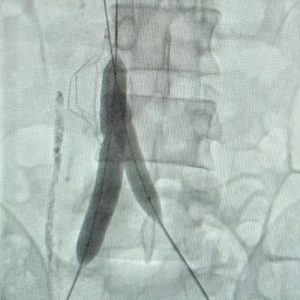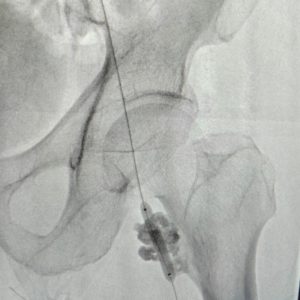Restoring Circulation, Renewing Vitality
Expert, minimally invasive treatments for conditions affecting your veins and arteries—from varicose veins to life-threatening blockages.
Expert Care for Your Circulatory System
Your peripheral circulatory system—the vast network of arteries and veins beyond your heart—is essential for delivering oxygen and nutrients to your entire body. When this system is compromised, it can lead to symptoms ranging from cosmetic concerns to limb-threatening pain. Dr. Akash Bansal specializes in Peripheral Interventions, a suite of advanced, image-guided procedures designed to treat these conditions from within the vessels themselves. Our approach ensures maximum effectiveness with minimal invasion, getting you back on your feet faster.
Our Peripheral Vascular Solutions
1. Varicose Veins Treatment (Laser/Microwave/Glue/Sclerotherapy)
The Problem: Bulging, twisted, and painful varicose veins caused by weakened valves, leading to aching, swelling, and skin changes.
Our Solution: We offer the full spectrum of modern, non-surgical treatments. This includes Thermal Ablation (Laser/Microwave) to seal veins shut, Glue Embolization to bond them closed, and Sclerotherapy to collapse smaller spider and varicose veins.
Patient Benefit: Walk-in, walk-out procedures with no scars or lengthy downtime. Immediate relief from symptoms and restored confidence in the appearance of your legs.
2. Sclerotherapy for Vascular Malformations (Head to Toe)
The Problem: Birthmarks or abnormal tangles of blood vessels (like hemangiomas or venous malformations) that can be painful, disfiguring, or prone to bleeding.
Our Solution: We use ultrasound guidance to inject a sclerosing agent directly into the malformation. This medicine irritates the vessel lining, causing it to collapse and shrink over time.
Patient Benefit: A highly targeted treatment to improve appearance, reduce pain, and prevent complications without affecting surrounding skin or tissues.
3. Angioplasty & Stenting for Peripheral Artery Disease (PAD)
The Problem: Narrowed or blocked arteries in the legs (PAD) cause severe pain when walking, non-healing wounds, and in severe cases, risk of amputation.
Our Solution: A small balloon is inflated inside the narrowed artery to reopen it (Angioplasty). Often, a small mesh tube called a stent is placed to keep the vessel open and ensure robust blood flow.
Patient Benefit: Saves limbs, relieves debilitating pain, and restores mobility. A vital alternative to bypass surgery.
4. Dialysis Fistula Interventions
The Problem: A dialysis fistula or graft—a lifeline for patients with kidney failure—can develop narrowings (stenosis) or clots that prevent effective dialysis.
Our Solution: We use specialized techniques like fistuloplasty (angioplasty of the fistula) and thrombectomy (clot removal) to clear the access and restore its function.
Patient Benefit: Preserves a patient’s vital dialysis access, avoiding the need for more invasive catheters or new surgery.
5. Venoplasty and Stenting
The Problem: Chronic blockages in deep veins (like Iliac Vein Compression) can cause leg swelling, pain, skin ulcers, and recurrent Deep Vein Thrombosis (DVT).
Our Solution: We open up the blocked vein using balloon venoplasty and may place a dedicated venous stent to hold it open, restoring healthy blood flow back to the heart.
Patient Benefit: Resolves chronic swelling, heals stubborn wounds, and significantly improves quality of life.
6. PICC Line / Central Line / Permcath / Dialysis Line Placement
The Problem: Patients needing long-term intravenous medication (like chemotherapy or antibiotics), nutrition, or dialysis require secure and reliable vascular access.
Our Solution: Using ultrasound and X-ray guidance, we accurately place various types of central venous catheters with maximum safety and precision.
Patient Benefit: Safer, more comfortable, and reliable access, reducing the need for repeated needle sticks and the risk of complications.
7. DVT & Pulmonary Embolism Treatment
The Problem: A blood clot in the deep veins of the leg (DVT) can break off and travel to the lungs (Pulmonary Embolism), a life-threatening emergency.
Our Solution: We offer advanced catheter-directed thrombolysis, where a catheter delivers clot-busting drugs directly into the clot, or thrombectomy, where the clot is mechanically broken up and removed.
Patient Benefit: Rapidly dissolves dangerous clots, saves lives, and reduces the long-term risk of permanent vein damage and leg pain (post-thrombotic syndrome).


Why Choose Dr. Akash Bansal for Peripheral Care?
Comprehensive Expertise: From cosmetic vein treatments to complex limb-saving procedures, we offer the full spectrum of peripheral vascular care.
Advanced Technology: We utilize the latest tools, including laser, microwave, and mechanical thrombectomy devices, to ensure the best possible outcomes.
A Focus on Preservation: Our primary goal is to save limbs, preserve dialysis access, and restore function using the least invasive means possible.
Collaborative Approach: We work closely with your vascular surgeons, nephrologists, and podiatrists to provide integrated, patient-centered care.
Frequently asked questions
Most thermal ablation or glue procedures allow you to walk out of the clinic and return to most normal activities, excluding heavy lifting and intense exercise, within 24-48 hours.
While highly effective, arteries can sometimes re-narrow over time (restenosis). The procedure successfully restores blood flow to heal wounds and relieve symptoms. Healthy lifestyle changes and follow-up are key to long-term success.
A PICC Line is typically for shorter-term use (weeks to months) for medications. A Permcath is a tunneled dialysis catheter designed for longer-term use in patients whose fistula is not yet ready.
Yes, the vast majority of these interventions, including varicose vein treatments when medically necessary, PAD treatments, and dialysis access care, are covered by insurance as they are essential, standard-of-care procedures.
While not all DVTs are emergencies, any symptoms of Pulmonary Embolism (sudden shortness of breath, chest pain, coughing up blood) require immediate emergency care. For extensive DVTs, prompt treatment can prevent long-term complications.


